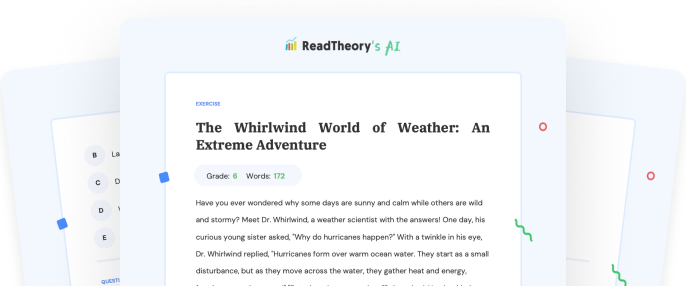Transform Your Teaching
with AI-Powered Worksheets
With ReadTheory’s Instant Worksheet Builder, you can create engaging, grade-appropriate worksheets tailored to your students in minutes. Spark curiosity, save time, and empower critical thinking with AI-powered tools designed for teachers like you.


The Unraveling Fury: Understanding Hurricanes
As a hurricane scientist, I study these giant, swirling storms that form over warm ocean waters. Hurricanes are a fascinating yet terrifying force of nature, their power enough to change landscapes and affect lives. They form when warm, moist air over the ocean rises, creating a low pressure area which then draws in surrounding air, creating a cyclonic effect. The structure of a hurricane, with its calm eye center and spiraling rainbands, is as unique as its formation. It is in these rainbands where the storm's power truly lies, with wind speeds that can exceed 157 miles per hour in a Category 5 storm. Hurricanes are categorized from 1 to 5 based on their wind speed. Category 1 has the lowest speeds, while Category 5 is the most devastating, with speeds over 157 miles per hour. In 2005, Hurricane Katrina, a Category 5 storm, caused over $125 billion in damage and claimed more than 1,200 lives. Despite their destructive nature, there are ways to prepare for hurricanes. Evacuation plans, emergency kits, and awareness of your local area's risk can all contribute to safety. As a hurricane scientist, my job is not only to understand these powerful storms but to help others prepare and stay safe.
Question 1
What is the meaning of the term 'cyclonic effect' as used in the text?
The effect of the storm on cyclones
A spinning motion of a storm
A change in temperature due to the storm
A sudden increase in wind speed
The after-effect of a hurricane
Question 2
What was the purpose of the author in writing this passage?
To scare readers about hurricanes
To detail the history of Hurricane Katrina
To explain how hurricanes form and how to prepare for them
To promote the profession of hurricane scientist
To discuss the economic impact of hurricanes
Question 3
According to the text, which statement is False about hurricanes?
Hurricanes form over warm ocean waters
The calm eye is at the center of a hurricane
Hurricane Katrina was a Category 4 storm
Wind speeds can exceed 157 miles per hour in a Category 5 storm
Evacuation plans can contribute to safety during hurricanes
Question 4
Based on the text, what can be inferred about Category 1 hurricanes compared to Category 5 hurricanes?
Category 1 hurricanes are more destructive
Category 1 hurricanes have higher wind speed
Category 5 hurricanes are less common
Category 5 hurricanes have higher wind speed
Both categories cause equal damage
Question 5
What does the 'eye' of a hurricane refer to?
The center of the storm
The strongest part of the storm
The outer edge of the storm
The area of highest wind speed
The portion of the storm above the ocean
 or share via
or share via

Assign the ReadTheory pretest to determine students' reading levels.

Why Teachers Love
Instant Worksheet Builder?

Tailored Content for Every Student
Craft worksheets with passages and multiple-choice questions customized to your chosen topic and grade level, ensuring relevance and engagement.

Save Hours
of Prep Time
Our AI, Lexi, generates complete worksheets—passages, questions, and answers—in minutes, freeing you to focus on teaching, not planning.

Standards-Aligned Learning
Every worksheet is designed to boost reading comprehension and critical thinking, aligning seamlessly with State Standards to help your students shine.
Personalized teaching
for personalized learning
Browse worksheets created and refined by educators using Lexi—your source for inspiration and ready-to-use resources.


ReadTheory is free for Teachers to use.
Join thousands of educators using ReadTheory for free. Sign up today and start creating in just minutes!





